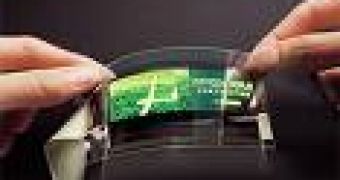Flexible electronics, also known as flex circuits or flex circuit boards, represent a technology for building electronic circuits by depositing electronic devices on flexible substrates such as plastic or even organic materials.
Having the potential to bend, expand and manipulate electronic devices, these new types of materials are being developed by researchers at the U.S. Department of Energy's Argonne National Laboratory and the University of Illinois at Urbana-Champaign.
So far, the team of researchers has been successful in fabricating thin ribbons of silicon and designing them to bend, stretch and compress like an accordion without losing their ability to function.
The purpose of this research is the forming of single-crystalline semiconductor nanoribbons in stretchable geometrical configurations with emphasis on the materials and surface chemistries used in their fabrication and the mechanics of their response to applied strains.
"Flexible electronics are typically characterized by conducting plastic-based liquids that can be printed onto thin, bendable surfaces," said scientist Yugang Sun, of the University of Illinois.
"The objective of our work was to generate a concept along with subsequent technology that would allow for electronic wires and circuits to stretch like rubber bands and accordions leading to sensor-embedded covers for aircraft and robots, and even prosthetic skin for humans. We are presently developing stretchable electronics and sensors for smart surgical gloves and hemispherical electronic eye imagers," he added.
There are many advantages to the developing of these flexible materials, like package size reduction, a simplified system design, considerable weight and thickness reduction, and the fact that they can dissipate heat at a better rate than any other dielectric material while providing the added benefits of vastly improved flexibility.
The applications fields vary from medicine and biology, as sensors and as electronic devices that can be integrated into artificial muscles or biological tissues, to energy technology as flexible and accurate sensors for hydrogen, and even to space sciences as flexible solar cells for powering satellites. These cells, that are lightweight, can be rolled up for launch, and are easily deployable.

 14 DAY TRIAL //
14 DAY TRIAL //